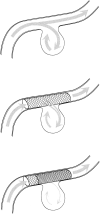Treatment of a ruptured dissecting vertebral artery aneurysm with double stent placement: case report
- PMID: 11733313
- PMCID: PMC7973848
Treatment of a ruptured dissecting vertebral artery aneurysm with double stent placement: case report
Abstract
A ruptured dissecting right vertebral artery aneurysm was treated by means of double stent placement with two overlapping stents. Control angiography performed 3 d after stent placement revealed beginning aneurysmal thrombosis. Substantial reduction in aneurysmal size was observed after 4 wk, whereas total occlusion was observed after 3 mo. The reduced stent porosity caused by the overlapping stents, which result in significant hemodynamic changes inside the aneurysmal sac, may accelerate intraaneurysmal thrombosis and may be helpful in achieving a more rapid complete occlusion compared with that achieved by single stent placement.
Figures




References
-
- Liu AY, Paulsen RD, Marcellus ML, Steinberg GK, Marks MP. Long-term outcomes after carotid stent placement treatment of carotid artery dissection. Neurosurgery 1999;45:1368-1374 - PubMed
-
- Bernstein SM, Coldwell DM, Prall JA, Brega KE. Treatment of traumatic carotid pseudoaneurysm with endovascular stent placement. J Vasc Interv Radiol 1997;8:1065-1068 - PubMed
Publication types
MeSH terms
LinkOut - more resources
Full Text Sources
Other Literature Sources
